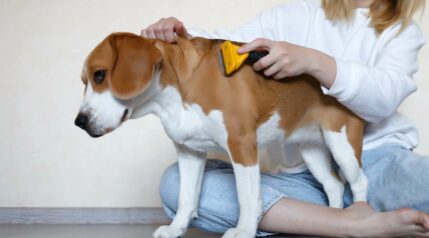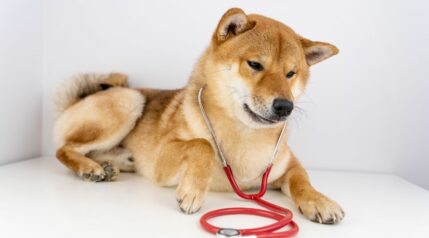If your dog is leaking urine, he could be suffering from urinary incontinence. This could mean wet bedding and puddles around the house, which can be frustrating for both you and your dog to live with.
It’s important to understand that there can be several causes, many of which are treatable. We explore these in more detail and what you can do to help your furry friend. Accurately diagnosed, the condition describes the loss of bladder control, resulting in the involuntary leaking of urine. This can vary from small dribbles to large puddles of urine. There are also times when it can be explained as a behavioral issue rather than a health concern.
Dogs are not usually aware that it is occurring and cannot stop it from happening. You should never ignore urinary incontinence, even if it’s at a manageable level, as it is an indication that something isn’t right. Let’s learn more about the condition and what to do should your dog start showing symptoms.
- What Is Incontinence In A Dog?
- What Are The Symptoms Of Urinary Incontinence?
- Are Certain Dog Breeds Prone To Urinary Incontinence?
- What Causes Urinary Incontinence?
- What Is The Treatment For Urinary Incontinence?
- How Can I Help My Dog With Urinary Incontinence?
- Will My Dog Be Okay If They Have Urinary Incontinence?
- Frequently Asked Questions
- Final Thoughts
What Is Incontinence In A Dog?
Incontinence describes a loss of bladder control. This is involuntary, and dogs can’t stop accidents from happening. The condition is seen quite frequently in dogs, with urine leaking out during sleep or even dripping out during the day. Fecal incontinence is also sometimes seen, where dogs accidentally pass poop without realizing it, especially as they age.

What Are The Symptoms Of Urinary Incontinence?
Your dog may show the following symptoms:
- Wet patches on bedding
- Damp fur around their rear end
- Red or irritated skin near the genitals
- Passing puddles or drips of urine without being aware they are doing it
- Sometimes blood may be seen in the urine, depending on the underlying cause
Are Certain Dog Breeds Prone To Urinary Incontinence?

Female dogs are usually affected more than males. Age is another contributing factor, with older dogs most likely to suffer from incontinence than younger ones. Predisposing factors include obesity and being spayed rather than remaining intact. For males, it is the opposite, and remaining intact (unneutered) can make certain problems more likely.
Some breeds are more likely to develop the condition. These tend to be larger dogs such as:
- German Shepherds
- Irish Setters
- Rottweiler
- Old English Sheepdogs
- English Springer Spaniels
- Dalmatians
- Weimaraners
- Boxers
What Causes Urinary Incontinence?

Many different underlying conditions could cause a dog to leak urine, including:
Urethral Sphincter Mechanism Incompetence
Urethral sphincter mechanism incompetence (USMI) is the most common cause of an incontinence diagnosis in dogs. The urethra is the tube that carries urine from the bladder to the outside world, and in dogs with USMI, it doesn’t close tightly enough.
The condition affects predominantly female dogs, and while it is complicated and multifactorial, a reduction in estrogen is thought to be a contributing factor for some animals. This means spayed females with lower estrogen levels are more likely to suffer from this complaint. It can also be seen in male dogs, but is much less common.
Affected dogs are commonly well otherwise and can urinate normally, but leak urine when lying down or sleeping. Their fur may become damp and skin could become irritated through constant contact with urine. Diagnostics such as blood tests, urine samples, and imaging may be performed, to rule out other health conditions.
Treatment
Treatment usually involves medications such as alpha-adrenergic (phenylpropanolamine) therapy which causes constriction (tightening) of the smooth muscle in the urethral sphincter, helping to stop leaking. Estrogen or estrogen derivatives are also often used to treat this condition. Weight loss can also help in conjunction with these medications. Occasionally surgical treatments are explored.
Ectopic Ureter(s)
Young animals with incontinence usually have a birth defect called ectopic ureter(s). The ureters are the tubes that carry urine from the kidneys down to the bladder. In affected dogs, one or both ureters don’t have their normal insertion into the bladder and instead connect to somewhere abnormal like the vagina or urethra. This means dogs may leak and drip urine.
Female dogs are most affected and other abnormalities may also exist alongside this such as a small bladder, short urethra, and vaginal issues. These dogs are usually incontinent from birth, but not always.
Diagnosis And Treatment
Diagnostic imaging such as ultrasound and CT scans are used to identify the issue. Treatment involves surgical adjustment of the ectopic ureters or laser correction.
Prostate Problems (Males)
The prostate is a gland found in male dogs just behind the bladder. Due to its proximity to the bladder and urethra, if the prostate becomes diseased it can affect how well a dog can hold its urine. This includes benign prostatic hyperplasia, a condition affecting many older unneutered male dogs, where the prostate becomes generally enlarged. Other conditions such as cancer, prostatitis (inflammation of the prostate) and abscesses can all cause similar symptoms.
Treatment
Neutering is often the treatment of choice because it helps reduce the prostate’s size. Another way to reduce the size of the prostate can be done surgically or chemically (with a testosterone-blocking implant). Infections of the prostate also require antibiotic treatments.
Perineal Hernias
Another condition that commonly affects males more than it does females is perineal herniation. This occurs when there is a weakness in the muscles near the dog’s anus causing their abdominal organs to herniate. This appears like a soft swelling on one or both sides of the dog’s bottom. This hernia can cause the bladder to move out of its normal position, leading to incontinence.
Many factors contribute to a hernia occurring in the first place, including hormonal imbalances, disease or enlargement of the prostate gland, and chronic constipation. Given that this condition primarily affects intact male dogs, testosterone is thought to have the biggest influence on its occurrence.
Treatment
Surgery is the treatment of choice to repair this condition, with neutering also being recommended at the same time, to reduce the risk of reoccurrence.
Urinary Tract Infections
Urinary tract infections (or UTIs) can cause swelling and pain, which can lead to urinary incontinence in some animals. Other signs of a UTI in dogs include:
- Straining to pass urine
- Blood in the urine
- A stronger smelling urine
- Discomfort when peeing
- Passing small amounts of pee frequently
Similar symptoms may also be seen with bladder stones (uroliths).
A UTI can occur in conjunction with some of the other conditions discussed above such as urethral sphincter mechanism incompetence and ectopic ureters. These structural abnormalities in the urinary tract can make secondary infection more likely to occur, as bacteria find it easier to enter and go up the tract.
Spinal Or Nerve Conditions
Dogs that have suffered spinal injuries may suffer from urinary conditions depending on the location and type of injury they have suffered. Defecation may also be affected, meaning fecal incontinence. This incontinence may be temporary and could resolve as injuries improve, or in some cases, it may be permanent.
Urinary Tract Tumors
Tumors affecting the urinary tract could cause issues with urination. This could be incontinence, but some animals may show other signs such as difficulty urinating or blood in the urine. Diagnostic imaging like x-rays and ultrasound is used to diagnose tumors.
Other Conditions
Other conditions may appear to make dogs incontinent. They may have increased thirst, creating a greater volume of urine, making pee accidents more likely. These include hormonal conditions like Cushing’s disease, diabetes, and kidney disease.
Some elderly dogs may also suffer from cognitive dysfunction which can confuse them leading to accidents in the house.
What Is The Treatment For Urinary Incontinence?

Your vet needs to do some tests to reach a diagnosis. This could involve blood samples to check kidneys, blood sugar, and liver amongst other things. A urine sample can be examined and cultured for any bacterial infections.
Diagnostic imaging is often required, to visualize the urinary tract and look for any structural abnormalities or things like bladder stones and tumors.
Treatment could involve medications (e.g for sphincter mechanism incompetence or urinary tract infections) or surgery (e.g. for ectopic ureters). Your vet should talk you through the options for your dog’s condition.
How Can I Help My Dog With Urinary Incontinence?
In addition to seeking help from a veterinarian to diagnose and treat the underlying cause of a dog’s incontinence, there are some practical steps you can take to help your pet in the meantime.
- Never punish or scold your dog for having accidents. They are unable to control their urination and are not doing it intentionally.
- Have a stock of easy-to-wash bedding, so that you can change it regularly.
- Puppy pads or incontinence sheets may be helpful in some cases to protect beds and furniture in particular
- Make sure your dog has plenty of opportunities to get outside to urinate during the day and ensure they’ve been out one last time at night to empty their bladder
- If leaking is severe, you may want to look into diapers
- Regularly wash and dry the skin around your dogs’ genitals to keep it free from urine which can scald the skin.
- And finally, never withhold water from your pet, they should always have free access to this
Will My Dog Be Okay If They Have Urinary Incontinence?
Many dogs respond well to prompt treatment, so always seek advice from your veterinarian if you think your dog is suffering from this condition. Your vet can suggest appropriate diagnostic tests for your pet and give you a recommended treatment plan based on their findings. Many dogs respond favorably to treatment, but there are some cases where the prognosis is poorer – such as those with very severe spinal injury or invasive tumors.
Frequently Asked Questions
Is It Normal For A Dog To Be Incontinent With An Infection?
Urinary tract infections can make some dogs incontinent. The swelling and pain that infections can cause may make some dogs leak urine. Other symptoms of a urinary tract infection include discomfort when peeing, blood in the urine, and passing urine often and in small amounts.
Can Incontinence Get Worse If Left Untreated?
As with many medical conditions, intervening earlier on leads to better outcomes, so try not to ignore the situation. Take your pup for a check-up with the vet if you suspect there might be a problem going on.
Final Thoughts
Urinary incontinence is very common in dogs, so don’t be embarrassed if you think your dog is suffering from this condition. There are many underlying reasons why dogs might be incontinent, so your vet can suggest some diagnostics to try and understand what is going on. Your vet can then recommend an appropriate course of treatment and hopefully, your dog (and their bedding) will be smelling sweeter in no time.





